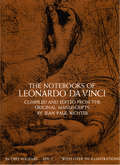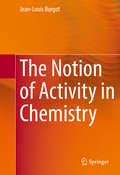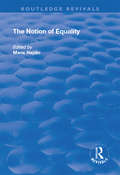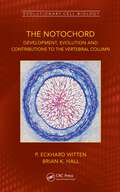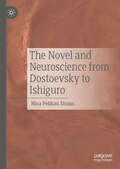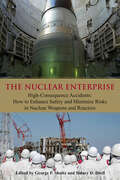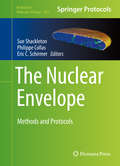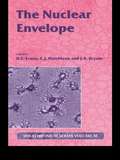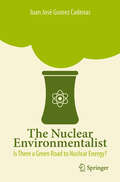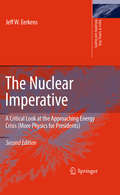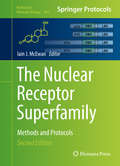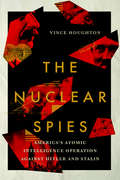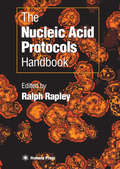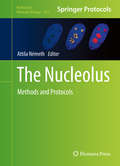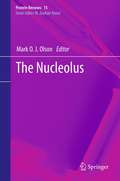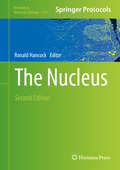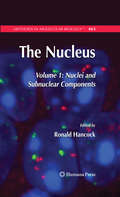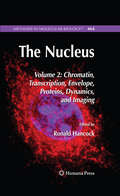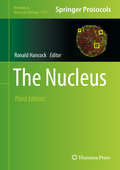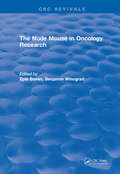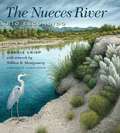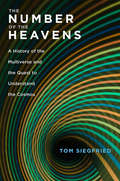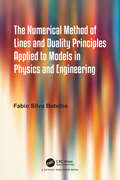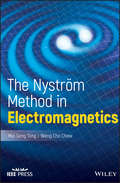- Table View
- List View
The Notebooks of Leonardo da Vinci, Vol. 1 (Dover Fine Art, History of Art #1)
by Leonardo Da VinciScientist, painter, mechanical engineer, sculptor, thinker, city planner, storyteller, musician, architect — Leonardo da Vinci, builder of the first flying machine, was one of the great universal geniuses of Western civilization. His voluminous notebooks, the great storehouse of his theories and discoveries, are presented here in 1566 extracts that reveal the full range of Leonardo's versatile interest: all the important writings on painting, sculpture, architecture, anatomy, astronomy, geography, topography, and other fields are included, in both Italian and English, with 186 plates of manuscript pages and many other drawings reproduced in facsimile size.The first volume, which contains all of Leonardo's writings on aspects of painting, includes discussions of such basic scientific areas as the structure of the eye and vision, perspective, the science of light and shade, the perspective of disappearance, theory of color, perspective of color, proportions and movements of the human figure, botany for painters, and the elements of landscape painting. A section on the practice of painting includes moral precepts for painters and writings on composition, materials, and the philosophy of art. The second volume contains writings on sculpture, architecture (plans for towns, streets, and canals, churches, palaces, castles, and villas, theoretical writings on arches, domes, fissures, etc.), zoology, physiology (including his amazingly accurate theories of blood circulation), medicine, astronomy, geography (including has famous writings and drawings on the movement of water), topography (observations in Italy, France, and other areas), naval warfare, swimming, theory of flying machines, mining, music, and other topics.A selection of philosophical maxims, morals, polemics, fables, jests, studies in the lives and habits of animals, tales, and prophecies display Leonardo's abilities as a writer and scholar. The second volume also contains some letters, personal records, inventories, and accounts, and concludes with Leonardo's will. The drawings include sketches and studies for some of Leonardo's greatest works of art — The Last Supper, the lost Battle of Anghiari, The Virgin of the Rocks, and the destroyed Sforza monument.
The Notion of Activity in Chemistry
by Jean-Louis BurgotThis book provides deep insight into the physical quantity known as chemical activity. The author probes deep into classical thermodynamics in Part I, and then into statistical thermodynamics in Part II, to provide the necessary background. The treatment has been streamlined by placing some background material in appendices. Chemical Activity is of interest not only to those in chemical thermodynamics, but also to chemical engineers working with mass transfer and its applications - for example, separation methods.
The Notion of Equality (The International Research Library of Philosophy #Vol. 25)
by Mane HajdinThis title was first published in 2001. In the articles collected in this anthology, contemporary analytic philosophers examine the ways in which the notion of equality functions in moral and political discourse. Among the topics discussed are the relationship between the ideal of equality and formal features of moral discourse, the conflict between the ideal of equality of welfare and the ideal of equality of resources and the relationship between the equality of opportunity and the equality of results.
The Notochord: Development, Evolution and contributions to the vertebral column (Evolutionary Cell Biology)
by Brian K. Hall P. Eckhard WittenAlthough it is the defining organ of the Chordata, the notochord and its cells are one of the least understood vertebrate organs. This may be because large parts of the notochord are often replaced with cartilaginous or bony vertebral bodies. The presence of cartilage in the notochord raises questions about the evolutionary relationships between notochord cells and cartilage cells. This book integrates classical analytical studies with recent palaeontological, experimental, and molecular studies in both developmental and evolutionary contexts. For example, although the early signaling function of the notochord is conserved across the vertebrates, many will be surprised to find that the role of the notochord in vertebral body development in tetrapods is not the blueprint for all vertebrates. Recent studies on zebrafish and medaka embryos have uncovered the molecular mechanisms of a somite-independent notochord-driven segmentation process that establishes vertebral centra and intervertebral spaces. As this process is not restricted to teleosts, the authors have written a general discussion about the role of the notochord in vertebral formation. Modularity and segmentation of the vertebral column are related topics. Further overarching themes are the structure, function and fate of the notochord in adult vertebrates and notochord–cartilage relationships. Key Features The first book devoted to notochord development, function and evolution Includes and integrates information on the notochord from studies going back 169 years Integrates developmental, molecular, functional, experimental and palaeontological studies Documents the fate of the notochord across the vertebrates Extensively illustrated with classical and new images Related Titles Bard, J. Evolution: The Origins and Mechanisms of Diversity (ISNB 978-0-3673-5701-6) Leys, S. and Hejnol. A. Origin and Evolution of Metazoan Cell Types (ISBN 978-1-1380-3269-9)
The Novel and Neuroscience from Dostoevsky to Ishiguro
by Nina Pelikan StrausThe Novel and Neuroscience from Dostoevsky to Ishiguro explores how affective neuroscience illuminates the emotional and ethical impact of eight novels written between 1864 and 2018, indicating how Freud’s provisional ideas in psychology are now being placed on an organic foundation. An emerging new language describes the brain and body’s primary-process powers now influencing the practices of literary theory, verifying the novel’s importance for self and cultural understanding.
The Nuclear Enterprise: High-Consequence Accidents: How to Enhance Safety and Minimize Risks in Nuclear Weapons and Reactors
by George P. Shultz Sidney D. DrellA panel of expert contributors offers its views on the risks and rewards of the nuclear enterprise, focusing on issues of safety, regulation, and public perception. Contributors discuss specific experience and issues regarding the technical safety of weapons and power plants, management operations, regulatory measures, and the importance of accurate communication by the media.
The Nuclear Envelope
by Philippe Collas Eric C. Schirmer Sue ShackletonThis volume provides a wide rangeof protocols used in studying the nuclear envelope, with special attention tothe experimental adjustments that may be required to successfully investigatethis complex organelle in cells from various organisms. The Nuclear Envelope:Methods and Protocols is divided into five sections: Part I - Nuclear EnvelopeIsolation; Part II - Nuclear Envelope Protein Interactions, Localization, andDynamics; Part III - Nuclear Envelope Interactions with the Cytoskeleton; PartIV - Nuclear Envelope-Chromatin Interactions; and Part V - Nucleo-CytoplasmicTransport. Many of the modifications discussed in this book have only beencirculated within laboratories that have conducted research in this field formany years. Written in the highly successful Methods in Molecular Biologyseries format, chapters include introductions to their respective topics, listsof the necessary materials and reagents, step-by-step, readily reproduciblelaboratory protocols, and tips on troubleshooting and avoiding known pitfalls. Cutting edge and thorough, The Nuclear Envelope: Methods and Protocols is a timely resource for researchers who have joined this dynamic and rapidly growing field.
The Nuclear Envelope: Vol 56 (Society for Experimental Biology)
by D. E. Evans C. J. Hutchison J. A. BryantThe Nuclear Envelope brings together the major current topics in nuclear envelope structure, transport, transcriptional regulation and cell signaling. The volume is divided into four sections:1. Proteins of the nuclear envelope, including nuclear envelope proteomics, structure and function.2. Nuclear pores and transport at the nuclear envelope, including pore complex structure, assembly and function and import and export pathways.3. Nuclear envelope dynamics, including dynamics of lamina assembly and disassembly.4. Nuclear signaling and transcription regulation, including signaling to the nucleus and spectrin repeat proteins and their implications or communication between the nucleus and cytoplasm.
The Nuclear Environmentalist
by Juan José Gomez CadenasThis book explains how society will face an energy crisis in the coming decades owing to increasing scarcity of fossil fuels and climate change impacts. It carefully explores this coming crisis and concisely examines all of the major technologies related to energy production (fossil fuels, renewables, and nuclear) and their impacts on our society and environment. The author argues that it is wrong to pit alternatives to fossil fuels against each other and proposes that nuclear energy, although by no means free of problems, can be a viable source of reliable and carbon-free electricity. He concludes by calling for a diversified and rational mix of electricity generation in order to mitigate the effects of the energy crisis. Throughout, the book is spiced with science, history, and anecdotes in a way that ensures rewarding reading without loss of rigor.
The Nuclear Imperative: A Critical Look at the Approaching Energy Crisis (More Physics for Presidents)
by Jeff EerkensIn this global wake-up call, nuclear physicist Jeff Eerkens explores remedies for the impending energy crisis, when oil and natural gas are depleted. The Nuclear Imperative demonstrates that solar, wind, and biomass power are incapable of supplying the enormous quantities of electricity and heat needed for manufacturing portable synthetic fuels to replace our current use of fossil fuels. It offers a fresh look at uranium-produced energy as the optimal affordable solution.
The Nuclear Pore Complex: Methods and Protocols (Methods in Molecular Biology #2502)
by Martin W. GoldbergThis volume covers all methods used to discover the composition, structure, and dynamics of the nuclear pore complex (NPC), as well as the soluble transport factors involved in the transport process. Chapters detail structural biology methods, biophysical, transport factors , and a wide range of model organisms that have been used over the years. Written in the format of the highly successful Methods in Molecular Biology series, each chapter includes an introduction to the topic, lists necessary materials and reagents, includes tips on troubleshooting and known pitfalls, and step-by-step, readily reproducible protocols. Authoritative and cutting-edge, The Nuclear Pore Complex: Methods and Protocols: Methods and Protocols aims to be a useful and practical guide to new researchers and experts looking to expand their knowledge.
The Nuclear Receptor Superfamily
by Iain J. McewanActing principally to control patterns of gene expression, nuclear receptors play vital roles during embryonic development and in the regulation of metabolic and reproductive functions in adult life, which proves this superfamily of ligand-activated transcription factors to be a crucial part of biological life. In The Nuclear Receptor Superfamily: Methods and Protocols, expert researchers describe a range of molecular, structural and cell biological techniques currently used to investigate the structure-function of nuclear receptors, together with experimental approaches that may lead to new therapeutic strategies for treating nuclear receptor-associated diseases. Written in the highly successful Methods in Molecular BiologyTM series format, the chapters in this volume contain brief introductions to the topics, lists of the necessary materials and reagents, step-by-step, readily reproducible laboratory protocols, as well as notes from the experts to highlight tips on troubleshooting and avoiding known pitfalls. Cutting-edge and easy to use, The Nuclear Receptor Superfamily: Methods and Protocols provides beneficial and time-saving guidance for all those undertaking research in this ever-growing field of study.
The Nuclear Spies: America's Atomic Intelligence Operation against Hitler and Stalin
by Vince HoughtonWhy did the US intelligence services fail so spectacularly to know about the Soviet Union's nuclear capabilities following World War II? As Vince Houghton, historian and curator of the International Spy Museum in Washington, DC, shows us, that disastrous failure came just a few years after the Manhattan Project's intelligence team had penetrated the Third Reich and knew every detail of the Nazi 's plan for an atomic bomb. What changed and what went wrong?Houghton's delightful retelling of this fascinating case of American spy ineffectiveness in the then new field of scientific intelligence provides us with a new look at the early years of the Cold War. During that time, scientific intelligence quickly grew to become a significant portion of the CIA budget as it struggled to contend with the incredible advance in weapons and other scientific discoveries immediately after World War II. As Houghton shows, the abilities of the Soviet Union's scientists, its research facilities and laboratories, and its educational system became a key consideration for the CIA in assessing the threat level of its most potent foe. Sadly, for the CIA scientific intelligence was extremely difficult to do well. For when the Soviet Union detonated its first atomic bomb in 1949, no one in the American intelligence services saw it coming.
The Nucleic Acid Protocols Handbook
by Ralph RapleyA comprehensive treasury of all the key molecular biology methods-ranging from DNA extraction to gene localization in situ-needed to function effectively in the modern laboratory. Each of the 120 highly successful techniques follows the format of the much acclaimed Methods in Molecular BiologyTM series, providing an introduction to the scientific basis of each technique, a complete listing of all the necessary materials and reagents, and clear step-by-step instruction to permit error-free execution. Included for each technique are notes about pitfalls to avoid, troubleshooting tips, alternate methods, and explanations of the reasons for certain steps-all key elements contributing significantly to success or failure in the lab. The Nucleic Acid Protocols Handbook constitutes today's most comprehensive collection of all the key classic and cutting-edge techniques for the successful isolation, analysis, and manipulation of nucleic acids by both experienced researchers and those new to the field.
The Nucleolus
by Attila NémethThis volume provides an up-to-date compilation of current methodological approaches utilized for the exploration of nucleolar structure and function. Chapters cover a diversity of protocols that include imaging of the nucleolus, analysis of ribosomal RNA transcription and processing, and genomics and proteomics of the nucleolus. Written in the highly successful Methods in Molecular Biology series format, chapters include introductions to their respective topics, lists of the necessary materials and reagents, step-by-step, readily reproducible laboratory protocols, and tips on troubleshooting and avoiding known pitfalls. Authoritative and practical, The Nucleolus: Methods and Protocols provides scientists with a reliable practical handbook to facilitate the investigation of this nuclear compartment at the advanced level.
The Nucleolus
by Mark O. OlsonWithin the past two decades, extraordinary new functions for the nucleolus have begun to appear, giving the field a new vitality and generating renewed excitement and interest. These new discoveries include both newly-discovered functions and aspects of its conventional role. The Nucleolus is divided into three parts: nucleolar structure and organization, the role of the nucleolus in ribosome biogenesis, and novel functions of the nucleolus.
The Nucleus, 2nd Edition
by Ronald HancockThis volume presents detailed, recently-developed protocols ranging from isolation of nuclei to purification of chromatin regions containing single genes, with a particular focus on some less well-explored aspects of the nucleus. The methods described include new strategies for isolation of nuclei, for purification of cell type-specific nuclei from a mixture, and for rapid isolation and fractionation of nucleoli. For gene delivery into and expression in nuclei, a novel gentle approach using gold nanowires is presented. As the concentration and localization of water and ions are crucial for macromolecular interactions in the nucleus, a new approach to measure these parameters by correlative optical and cryo-electron microscopy is described. The Nucleus, Second Edition presents methods and software for high-throughput quantitative analysis of 3D fluorescence microscopy images, for quantification of the formation of amyloid fibrils in the nucleus, and for quantitative analysis of chromosome territory localization. Written in the successful Methods in Molecular Biology series format, chapters include introductions to their respective topics, lists of the necessary materials and reagents, step-by-step, readily reproducible protocols, and notes on troubleshooting and avoiding known pitfalls.<P><P> Authoritative and easily accessible, The Nucleus, Second Edition seeks to serve both professionals and novices with its well-honed methods for the study of the nucleus.
The Nucleus, Volume 1: Nuclei and Subnuclear Components
by Ronald HancockAlthough our understanding of the structure and activities of the cell nucleus and of the nanomachines which it contains is increasing rapidly, much remains to be learned. The application and continuing development of the new, powerful biochemical and biophysical methodologies described here are essential in this quest. In The Nucleus, researchers from more than forty leading international laboratories describe state-of-the-art methods for isolating nuclei and their components and for studying their structure and activities, including some pathology-associated features. Volume I: Nuclei and Subnuclear Structures presents an overview of features of the intranuclear environment, followed by the most recent procedures for isolating nuclei from a wide range of cell types including muscle cells, yeast, oocytes, cells with polytene nuclei, Arabidopsis, trypanosomes, and dinoflagellates. The latest methods are described for isolating and working with nucleoli, constitutive heterochromatin, pathology-associated inclusions, and chromatin and for examining glycosylation, sumoylation, and ADP-ribosylation of nuclear proteins. Written in the highly successful Methods in Molecular Biology™ series format, chapters contain lists of necessary materials and reagents, readily reproducible protocols, and tips for troubleshooting and avoiding known pitfalls.<P><P> The Nucleus, Volume I: Nuclei and Subnuclear Structures is an essential reference for scientists who are working on our rapidly growing understanding of the cell nucleus and its activities.
The Nucleus, Volume 2: Chromatin, Transcription, Envelope, Proteins, Dynamics, and Imaging
by Ronald HancockAlthough our understanding of the structure and activities of the cell nucleus and of the nanomachines which it contains is increasing rapidly, much remains to be learned. The application and continuing development of the new, powerful biochemical and biophysical methodologies described here are essential in this quest. In The Nucleus, researchers from more than forty leading international laboratories describe state-of-the-art methods for isolating nuclei and their components and for studying their structure and activities, including some pathology-associated features. Volume 2: Chromatin, Transcription, Envelope, Proteins, Dynamics, and Imaging presents biophysical approaches to study the mechanical properties of nuclei, together with a comprehensive range of imaging methods. These include FISH, FRAP, FRET, molecular beacons, fluorescence correlation spectroscopy, single molecule tracking, and combing DNA for optical microscopy, recognition imaging for atomic force microscopy, and hybridisation, tomography, and spectroscopic imaging for electron microscopy. Written in the highly successful Methods in Molecular Biology™ series format, chapters contain lists of necessary materials and reagents, readily reproducible protocols, and tips for troubleshooting and avoiding known pitfalls.<P><P> The Nucleus, Volume 2: Chromatin, Transcription, Envelope, Proteins, Dynamics, and Imaging provides a comprehensive collection of the cutting-edge methods making a major contribution to understanding the nucleus and its nanostructure today.
The Nucleus: Volume 1: Nuclei And Subnuclear Components (Methods in Molecular Biology #2175)
by Ronald HancockThis detailed new edition delves into recently developed protocols for those working on cell nucleus research, including some of the less well-explored areas of study. Like the previous editions, this book features contributions from top experts in their respective fields. Written for the highly successful Methods in Molecular Biology series, chapters include introductions to their topics, lists of the necessary materials and reagents, step-by-step, readily reproducible laboratory protocols, and tips on troubleshooting and avoiding known pitfalls. Authoritative and up-to-date, The Nucleus, Third Edition will help students and postdocs become aware of vital available methodologies when planning their new projects.
The Nude Mouse in Oncology Research
by Epie BovenThe nude, athymic mouse (nu/nu) has become generally accepted as a valuable tool to study the biology and therapy of human cancers. This volume presents a critical review of the scientific merits of the animal as a recipient of human tumor tissue transplants. Important information is provided regarding biology, immunology, and measures for genetic and microbiological control of the nude mouse. The discussion of transplantation sites and transplantability of human tumor tissue to the animals includes both the description of host factors and the tumor type involved. The characterization and monitoring of xenografts is followed by a review on their possible application for studies in tumor biology, such as hormones, growth factors, drug resistance, tumor markers, and heterogeneity. Experimental therapy is dedicated to cytostatic agents, hormones, monoclonal antibodies, cytokines, differentiation inducers and radiotherapy. The book also provides critical remarks regarding the limitation of the nude-mouse tumor models. The Nude Mouse in Oncology Research will provide essential reference information for oncology researchers, researchers who work with the nude mouse on a regular basis, and pharmaceutical companies.
The Nueces River: Río Escondido (River Books)
by Margie CrispFirst appearing on early Spanish maps as the Río Escondido, or hidden river, and later named Río de las Nueces after the abundant pecan trees along its banks, the Nueces today is a stream of seeming contradictions: a river that runs above and below ground; a geographic reminder of a history both noble and egregious; and a spring-fed stream transformed into a salty, steep-sided channel. <P><P>From its fresh, clear headwaters on the Edwards Plateau, Margie Crisp and William B. Montgomery follow the river through the mesquite and prickly pear of the South Texas Plains, to the river’s end in Nueces and Corpus Christi Bays on the Gulf of Mexico. With vivid prose and paintings, they record their travels as they explore the length of the river on foot, kayak, and fishing boat, ultimately weaving a vivid portrait of today’s Nueces. Capturing the river’s subtle beauty, abundant wildlife, diverse culture, and unique history of exploration, conflict, and settlement, they reveal the untold story of this enigmatic river with passion, humor, and reverence.
The Number of the Heavens: A History of the Multiverse and the Quest to Understand the Cosmos
by Tom SiegfriedOne of the most controversial, cutting-edge ideas in cosmology—the possibility that there exist multiple parallel universes—in fact has a long history. Tom Siegfried reminds us that the size and number of the heavens have been contested since ancient times. His story offers deep lessons about the nature of science and the quest for understanding.
The Numerical Method of Lines and Duality Principles Applied to Models in Physics and Engineering
by Fabio Silva BotelhoThe book includes theoretical and applied results of a generalization of the numerical method of lines. A Ginzburg-Landau type equation comprises the initial application, with detailed explanations about the establishment of the general line expressions. Approximate numerical procedures have been developed for a variety of equation types, including the related algorithms and software. The applications include the Ginzburg-Landau system in superconductivity, applications to the Navier-Stokes system in fluid mechanics and, among others, models in flight mechanics. In its second and final parts, the book develops duality principles and numerical results for other similar and related models. The book is meant for applied mathematicians, physicists and engineers interested in numerical methods and concerning duality theory. It is expected the text will serve as a valuable auxiliary project tool for some important engineering and physics fields of research.
The Nystrom Method in Electromagnetics (Wiley - IEEE)
by Mei Song Tong Weng Cho ChewA comprehensive, step-by-step reference to the Nyström Method for solving Electromagnetic problems using integral equations Computational electromagnetics studies the numerical methods or techniques that solve electromagnetic problems by computer programming. Currently, there are mainly three numerical methods for electromagnetic problems: the finite-difference time-domain (FDTD), finite element method (FEM), and integral equation methods (IEMs). In the IEMs, the method of moments (MoM) is the most widely used method, but much attention is being paid to the Nyström method as another IEM, because it possesses some unique merits which the MoM lacks. This book focuses on that method—providing information on everything that students and professionals working in the field need to know. Written by the top researchers in electromagnetics, this complete reference book is a consolidation of advances made in the use of the Nyström method for solving electromagnetic integral equations. It begins by introducing the fundamentals of the electromagnetic theory and computational electromagnetics, before proceeding to illustrate the advantages unique to the Nyström method through rigorous worked out examples and equations. Key topics include quadrature rules, singularity treatment techniques, applications to conducting and penetrable media, multiphysics electromagnetic problems, time-domain integral equations, inverse scattering problems and incorporation with multilevel fast multiple algorithm. Systematically introduces the fundamental principles, equations, and advantages of the Nyström method for solving electromagnetic problems Features the unique benefits of using the Nyström method through numerical comparisons with other numerical and analytical methods Covers a broad range of application examples that will point the way for future research The Nystrom Method in Electromagnetics is ideal for graduate students, senior undergraduates, and researchers studying engineering electromagnetics, computational methods, and applied mathematics. Practicing engineers and other industry professionals working in engineering electromagnetics and engineering mathematics will also find it to be incredibly helpful.
